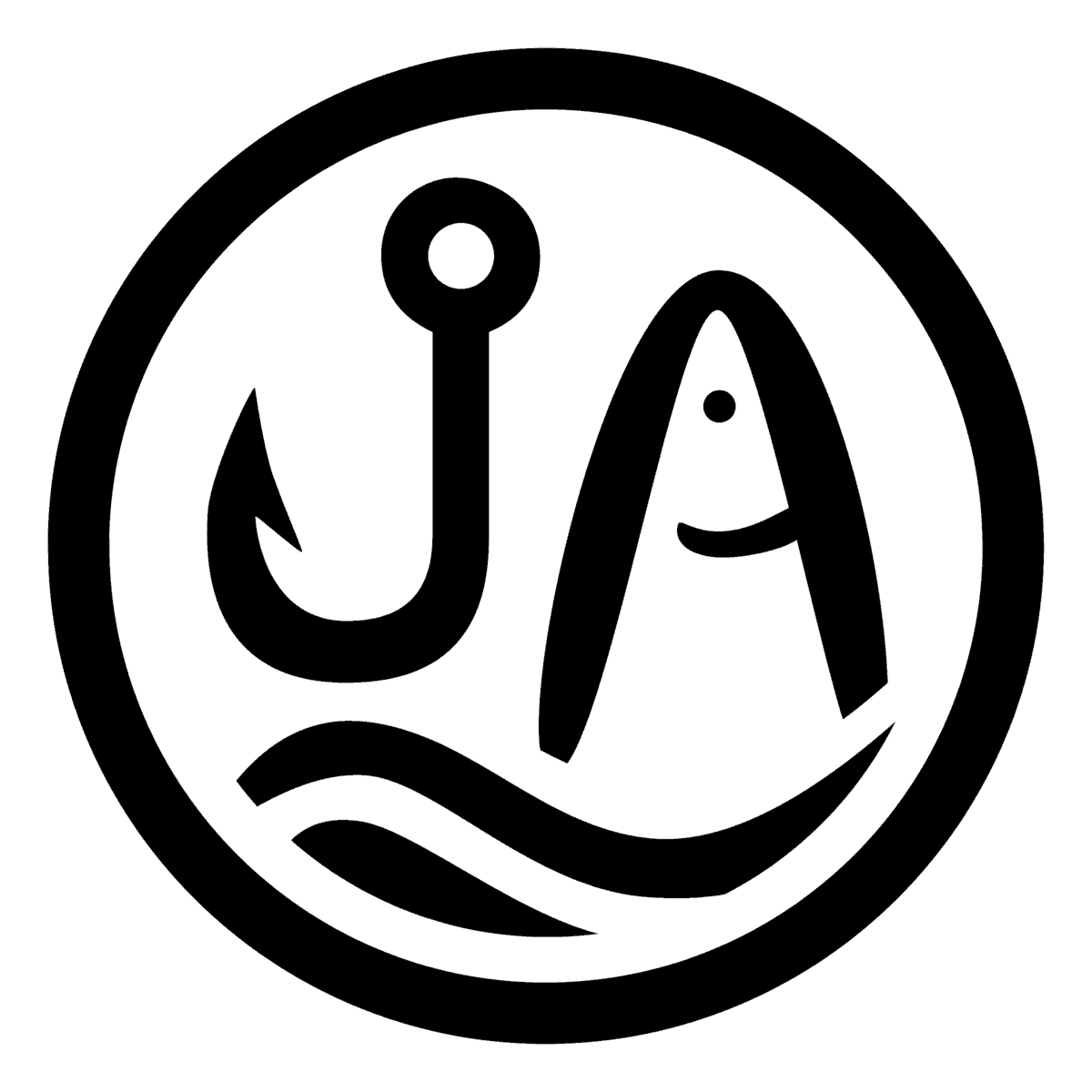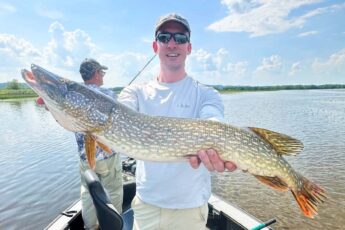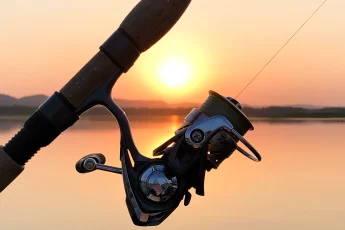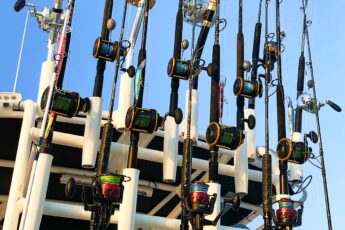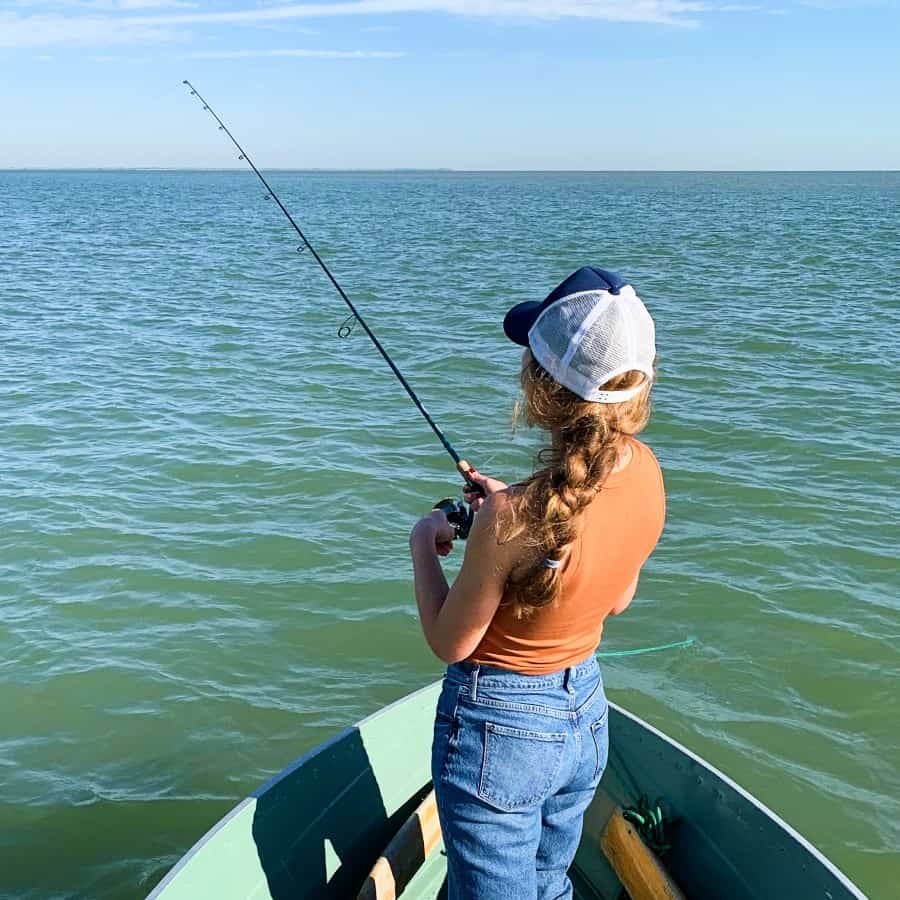
Updated 12/29/2023
Inshore fishing can be an absolute blast. Popular inshore species like redfish, speckled trout, flounder, sheepshead, striped bass, and black drum can put up considerable fights and are all excellent table fare. When pursuing these fish, it’s important to have the best inshore reels to handle both a tough fight and the saltwater conditions to maximize your chances at a successful catch.
In this article, we take a look at the best inshore reels on the market, considering factors like price, performance, quality, and value.
*Disclosure: I only recommend products I would use myself and all opinions expressed here are my own. This post may contain affiliate links that at no additional cost to you, I may earn a small commission.
Our Top 10 Picks
- Best Baitcasting Reel for the Money: Shimano Curado M Baitcasting Reel
- Best Baitcasting Reel Under $200: Abu Garcia Revo SX Baitcasting Reel
- Best Baitcasting Reel Spool Capacity: Daiwa Coastal TW 200 Baitcasting Reel
- Best Budget Baitcasting Reel: KastKing Kapstan Elite Baitcasting Reel
- Best Digital Brake Baitcasting Reel: Shimano Curado DC Baitcasting Reel
- Best Premium Baitcasting Reel: Penn Fathom Low Profile Baitcasting Reel
- Best Spinning Reel for the Money: Penn Battle III Spinning Reel
- Best Spinning Reel Under $100: KastKing Sharky III Spinning Reel
- Best Spinning Reel Under $150: Daiwa BG Spinning Reel
- Best Spinning Reel for Bull Reds: Penn Spinfisher VI Spinning Reel
The 10 Best Inshore Reels
Whether you’re a new angler or a grizzled expert, we have you covered. Check out our recommendations for best inshore reels by category like best budget, best for different price points, and best premium reels amongst others! We also cover considerations for spinning reels vs baitcasting reels for different techniques to target inshore species.
1. Shimano Curado M Baitcasting Reel

- Gear Ratio: 6.2:1 – 8.5:1
- Max Drag: 12 – 13 lbs
- Ball Bearings: 6+1
- Weight: 7.4 – 7.6 oz
Pros:
- Butter smooth
- Great casting distance
- Marketed for freshwater and saltwater
Our choice for best inshore baitcasting reel for the money is the Shimano Curado M. We picked it as our top choice because it’s a no-frills, high value proposition reel that’s built to last.
This reel is smooth as butter and feels like you can cast it a mile. It’s built for reliability and durability, rated for both freshwater and saltwater, and is an absolute delight to fish with.
Shimano recently released the Curado M as their flagship replacement for the Curado K. Compared to the Curado 200K, the Curado 200M is 0.2 oz lighter, has 2 lb higher max drag rating, and has Shimano’s MagnumLite (MGL) Spool III that reduces start-up inertia for unparalleled casting performance. Also, they added the SilentTune technology that reduces spool noise during casts.
The Curado M features Shimano’s latest MicroModule gearing they claim as super smooth and efficient. Spoilers, it is.
The Curado M baitcasting reel can do anything you want a baitcaster for inshore species to do from chucking soft plastics to throwing spoons.
I could go on and on about this reel. Suffice to say, if you want a smooth, durable, multi-function, long lasting baitcasting reel, the Shimano Curado M is a great choice.
If we had to pick one downside of this reel for saltwater fishing is the limited drag compared to other options on this list. If targeting huge fish, we recommend checking out the competition.
2. Abu Garcia Revo SX Baitcasting Reel
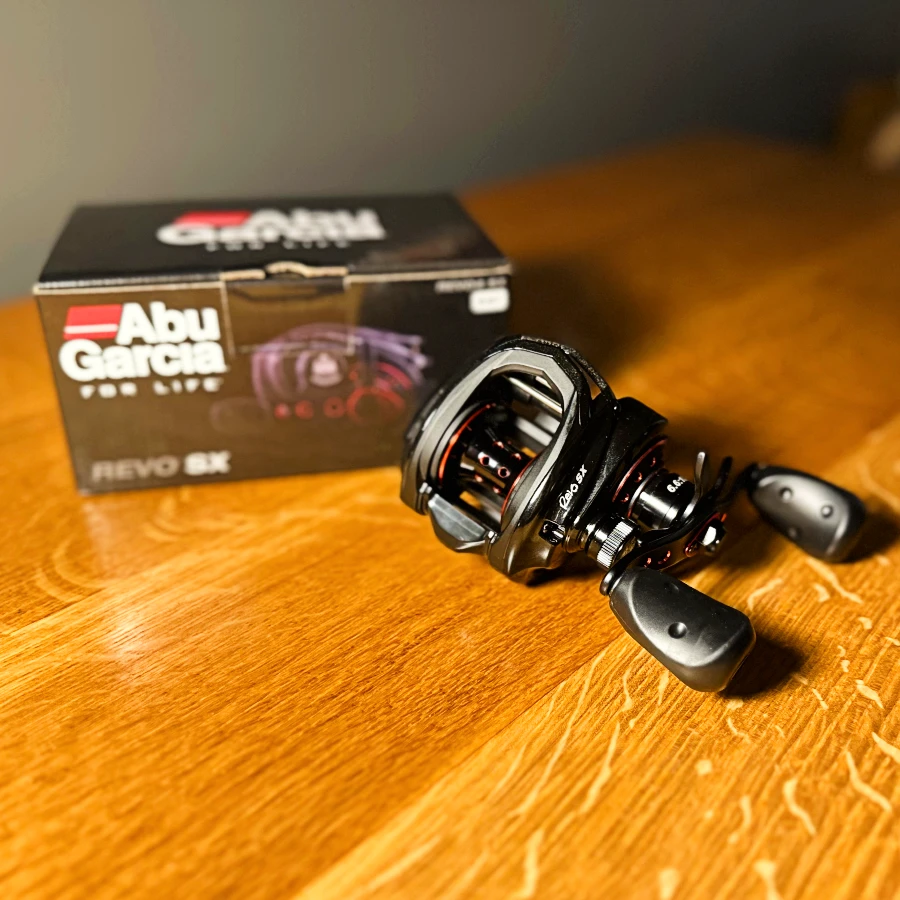
- Gear Ratio: 6.6:1 – 7.3:1
- Max Drag: 24 lbs
- Ball Bearings: 9+1
- Weight: 7.8 oz
Pros:
- Premium features at great value price
- Powerful drag
Our choice for the best inshore baitcasting reel under $200 is the Abu Garcia Revo SX. This is Abu Garcia’s most popular baitcasting reel for good reason. It’s lightweight, smooth, and a workhorse inshore fishing reel.
It includes a number of Abu Garcia’s technologies like the easily adjustable magnetic Infini brake system and ultra-smooth 9+1 ball bearings.
We like that this reel comes with higher drag options that are perfect for targeting large inshore fish.
The reel comes in both 6.6:1 and 7.3:1 gear ratios. Grab the 6.6:1 for great all-purpose saltwater fishing. Grab the 7.3:1 for burning topwaters or when you need to get a bunch of casts in.
Similar to our top choice, this is a great value option baitcasting reel that will last forever and is a delight to fish with.
3. Daiwa Coastal 200 TW Baitcasting Reel
- Gear Ratio: 7.3:1
- Max Drag: 15.4 lbs
- Ball Bearings: 7+1
- Weight: 8.1 oz
Pros:
- Fit for purpose
- High build quality
Our choice for the best inshore baitcasting reel with high spool capacity is the Daiwa Coastal TW 200 Reel. Daiwa created a perfect, fit-for-purpose inshore baitcasting reel that can fit plenty of sturdy fishing line for targeting inshore species. The 200 sizing, 15.4 lb drag, and 7.3:1 gear ratio are great for the needs of inshore fishing for specks, redfish, flounder, and striped bass.
The Daiwa Coastal baitcasting reel is the perfect size to pair with a popping cork, soft plastics, or your favorite inshore bait.
This reel is high strength and built to withstand the stress of fishing in corrosive saltwater conditions. It’s super smooth and an excellent option for saltwater fishing condition.
The spool on the Daiwa Coastal is comparatively larger than similar reels in it’s class. For example, it has capacity for 190 yards of 30 lb braid compared to the 140 yards of 30 lb braid on the Abu Garcia Revo SX. This increased spool capacity is something to think about if planning to use heavier lines and baits for targeting large fish.
4. KastKing Kapstan Elite Baitcasting Reel
- Gear Ratio: 5.4:1
- Max Drag: 35 lb
- Ball Bearings: 8+1
- Weight: 10.8 oz
Pros:
- Heavy duty for budget price
Our choice for the best budget inshore baitcasting reel is the KastKing Kapstan Elite Casting Reel in the 300 size. This reel is heavy duty with a massive 35 lb drag and large spool capable of holding 230 yards of 60 lb braid. It is a great budget entry point into inshore baitcasting reels.
This reel weighs more than comparable, higher priced reels on this list. The gear ratio options are limited to 5.4:1. That said, it is heavy duty, saltwater ready, and made to catch big species like stripers, redfish, snook, and speckled trout.
Remember, you don’t need expensive gear to catch fish! Don’t think twice about this as a solid budget entry point for saltwater baitcasters.
5. Shimano Curado DC Baitcasting Reel
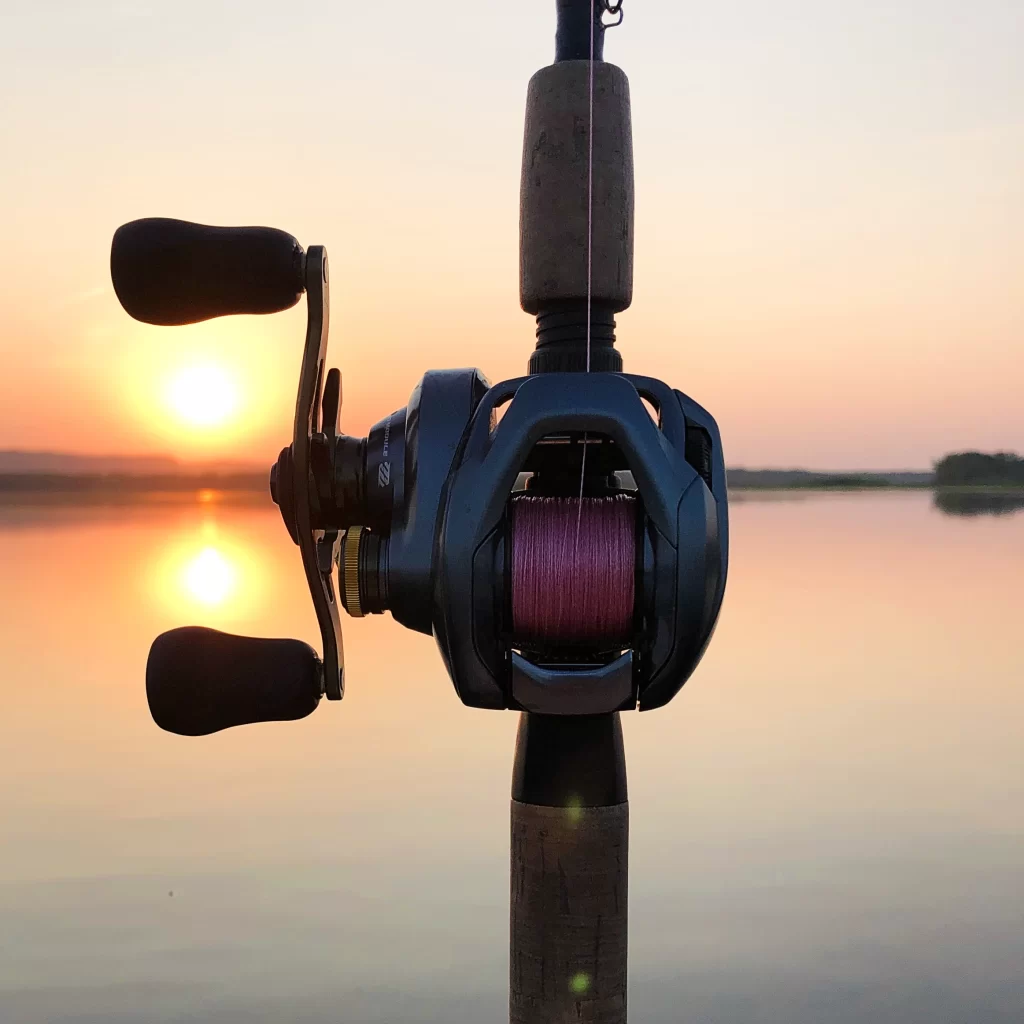
- Gear Ratio: 6.2:1 – 8.5:1
- Max Drag: 11 lbs
- Ball Bearings: 6+1
- Weight: 7.8 – 7.9 oz
Pros:
- Digital Control Brake makes it nearly impossible to backlash
Our choice for best digital brake inshore baitcasting reel is the Shimano Curado DC. Take our glowing recommendation for the Curado baitcasting reel line, slap a microcomputer controlled digital brake on it, and you have the Curado DC.
The Curado DC includes a digital braking system that utilizes a microcomputer to monitor spool speed at a speed of 1,000 times per second. The computer automatically applies the perfect amount of brake to prevent backlash at superhuman speeds. And what’s more amazing? No batteries required!
Backlash is most anglers’ biggest frustration with baitcasting reels. The Curado DC all-but removes the ability for the reel to backlash when set up properly. Casting into the wind? Light bait? Tried to cast too hard? No problem.
Everything else we’ve said on the Curado reel line still holds true. These reels include high quality components, have butter smooth reeling, and are super reliable.
The Curado DC is an awesome option for a high-end reel. Both beginners and experts alike will appreciate the high build quality and all-but removing the risk of backlash in the heat of the moment.
While we do love the digital brake, do note the max drag is only 11 lbs. If targeting the largest saltwater species, think about grabbing a heavier duty reel.
6. Penn Fathom Low Profile Reel Baitcasting Reel
- Gear Ratio: 6.6:1 – 9.2:1
- Max Drag: 24 – 30 lbs
- Ball Bearings: 6+1
- Weight: 8.1 – 13.9 oz
Pros:
- Available in 200, 300, and 400 sizes for targeting big fish
- High quality materials
Our choice for best premium inshore baitcasting reel is the Penn Fathom Low Profile Reel. This reel is built with high quality, corrosion-resistant, saltwater rated parts. It’s super smooth and comes in a great range of sizes perfect for heavier duty saltwater fishing.
The Penn Fathom baitcasting reel is perfect for targeting speckled trout, redfish, cobia, striped bass, flounder, and anything else that swims in saltwater. It has plenty of spool capacity, high drag rating, smooth action, and great gear ratios for targeting specks and reds. This reel should last a lifetime with it’s durable, high-end build quality.
Grab the 200 series size for inshore fishing. It fits 180 yards of 30 lb braid. Size up to 300 or 400 for nearshore fishing.
It’s also worth noting, this reel is gorgeous. Our recommendations primarily focus on functionality, but it’s worth mentioning how slick the black with gold accents looks.
7. Penn Battle III Spinning Reel
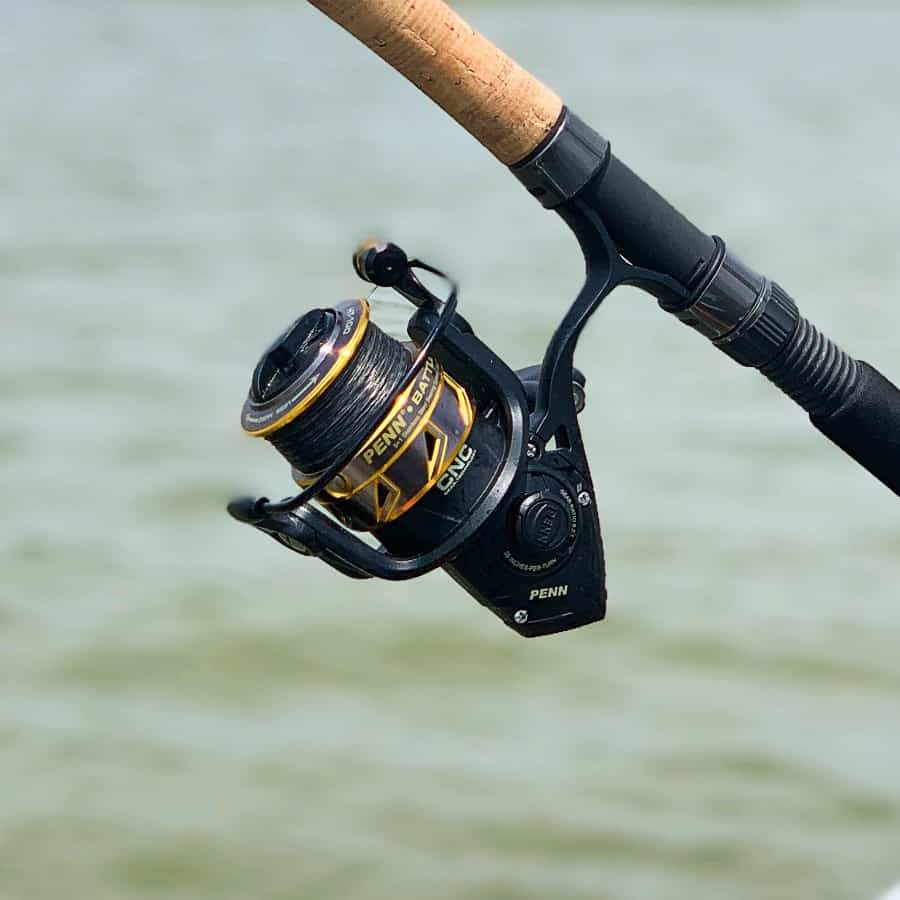
- Reel Sizes: 1000 to 8000
- Gear Ratio: 4.2:1 to 7.0:1
- Max Drag: 9 to 40 lb
- Ball Bearings: 5+1
- Weight: 7.8 to 38.8 oz
Pros:
- Premium reel features for reasonable price
Our choice for best inshore spinning reel for the money is the Penn Battle III spinning reel which we feel is that perfect mix of premium quality with a manageable price tag. This reel was the 2020 ICAST Online Best of Category Winner – Saltwater Reel for good reason!
The Battle III includes a 5+1 sealed stainless steel ball bearing system, Penn’s HT-100 carbon fiber drag washers, and a full metal aluminum body and side plate. It is high quality designed for durability and performance and Penn really outdid themselves with the attention to detail. Line capacity rings on the spool make for an easy visual reference to tell how much line you have to spare.
The material choices make for a lightweight reel with great corrosion resistance. Also, the spool is considered a ‘Superline Spool’ or a braid-ready spool. This means there is a little rubber ring on the spool that lets you directly tie braid to the spool without it slipping. A nice touch!
We recently attended a charity inshore fishing tournament in Galveston where we noticed our guide, Jesse, had Penn Battle III reels on all of his rods. When asked about it, Jesse said he fishes 250 days or more a year in saltwater conditions and does next to nothing to maintain these reels. He’s had no problems with them and loves how reliable they are considering how hard he works them. We even caught a 28″ redfish which placed for biggest fish in the tournament and a 25″ speckled trout on that trip with this reel!
No need to overthink it. This is a premium reel priced for value.
8. KastKing Sharky III Spinning Reel

- Reel Sizes: 1000 to 5000
- Gear Ratio: 5.2:1
- Max Drag: 33 to 39.5 lbs
- Ball Bearings: 10+1
- Weight: 7.4 to 10.6 oz
Pros:
- Budget friendly but still fit for purpose
Our choice for the best inshore spinning reel under $100 is the KastKing Sharky III spinning reel. You don’t need to break the bank for quality equipment. This reel hits above its weight class and gets the job done.
The key factor when picking a budget inshore spinning reel is to ensure manufacturers build it for saltwater. Saltwater construction means corrosion resistance materials and quality seals for rotating components. The reel is surprisingly smooth for its price point with a 10+1 bearing system.
The Sharky III has some great features like the K.I.S.S. (KastKing Intrusion Shield System) sealing system to improve water resistance for the spool, body, and rotor. The aluminum spool has a rubber backing to allow direct spooling of braided fishing line.
This reel contains most of the features of a high end reel but is priced for value.
While this reel may corrode faster than some of the higher end options on the list, if you take care of your reel with freshwater rinses and routine maintenance it should last quite a long time.
9. Daiwa BG Spinning Reel
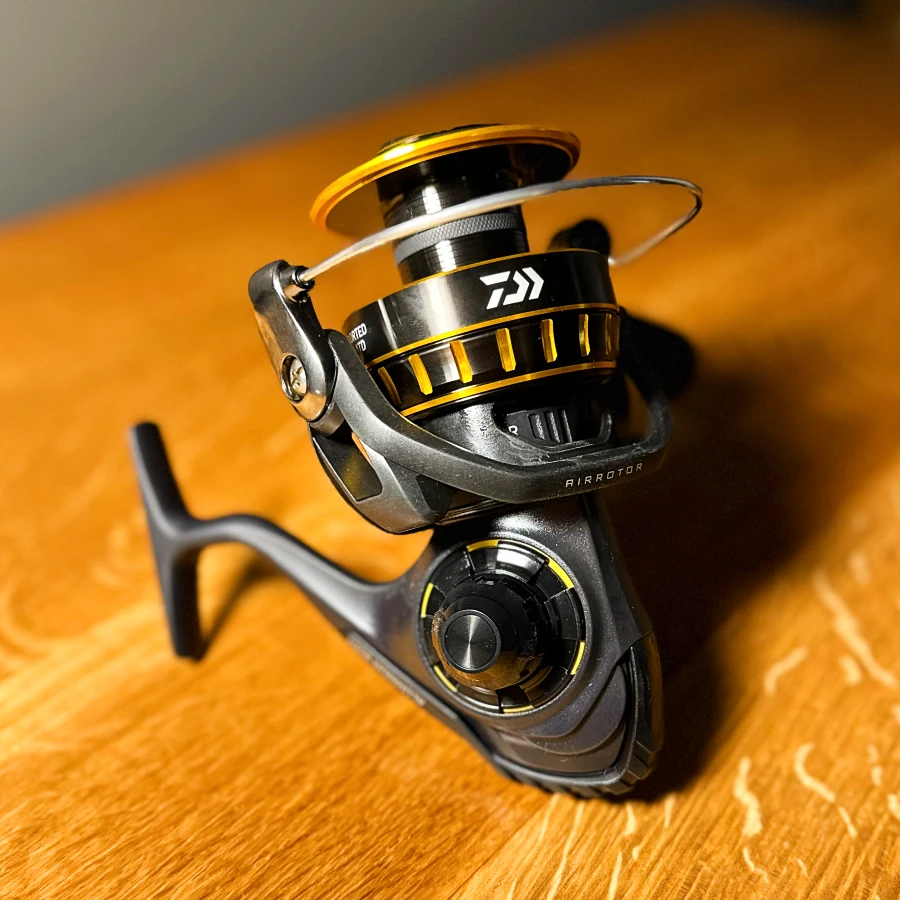
- Reel Sizes: 1500 to 8000
- Gear Ratio: 5.3:1 to 5.7:1
- Max Drag: 4.4 to 33
- Ball Bearings: 6+1
- Weight: 8.5 to 30 oz
Pros:
- Great all around reel
Our pick for the best inshore spinning reel under $150 is the Daiwa BG Spinning Reel. It’s a solidly constructed, quality reel that is perfect for targeting tailing redfish and speckled trout in the back marshes.
The reel includes Daiwa’s Automatic Tournament Drag (ATD) that reduces initial drag start-up inertia to create a smoother drag from initial startup. It also has digitally engineered gears to optimize speed, power, durability, and smoothness. Daiwa claims their tests reveal their reel gear life up to three times longer than competitors reels! We’re always looking for equipment that will last forever and this reel can take a beating.
Also, it doesn’t hurt that this reel just plain looks great with its sleek black anodized machined aluminum housing!
10. Penn Spinfisher VI Spinning Reel
- Reel Sizes: 2500 to 10500
- Gear Ratio: 4.2:1 to 6.2:1
- Max Drag: 15 to 50 lb
- Ball Bearings: 5+1
- Weight: 10.7 to 38.6 oz
Pros:
- Heavy duty workhorse
- Live line option
Our pick for the best inshore spinning reel for targeting bull reds is the Penn Spinfisher VI. This reel has the backbone and features needed to catch big bull reds.
Featuring an IPX5 sealed body and spool, full metal body/side plates, and a 5+1 sealed stainless steel bearing system, the Spinfisher VI has great durability and strength at a fair price point. The larger models have incredible max drag capabilities of up to 50 pounds which is more than enough for the largest saltwater species.
Just like with the Penn Battle III, the Spinfisher VI’s spool has the nice touches of a rubber backing superline spool that is ready for braid plus the line capacity rings for quick visual reference for how much line is left on the spool.
We like that the Spinfisher VI comes in a wide variety of sizes plus styles. Specifically, the live-line version is great for surf fishing. The live-line version has an additional switch on the reel that, once toggled, allows the spool to free-spool without flipping the bail. A great additional feature for saltwater anglers that fish with cut bait and circle hooks!
Reel Comparison Table
Check out our handy comparison table showing key specifications for our top reel choices.
| Reel Name | Gear Ratio | Max Drag | Ball Bearings | Weight |
|---|---|---|---|---|
| Shimano Curado M Baitcasting Reel | 6.2:1 – 8.5:1 | 12 – 13 lbs | 6+1 | 7.4 – 7.6 oz |
| Abu Garcia Revo SX Baitcasting Reel | 6.6:1 – 7.3:1 | 24 lbs | 9+1 | 7.8 oz |
| Daiwa Coastal 200 TW Baitcasting Reel | 7.3:1 | 15.4 lbs | 7+1 | 8.1 oz |
| KastKing Kapstan Elite Baitcasting Reel | 5.4:1 | 35 lb | 8+1 | 10.8 oz |
| Shimano Curado DC Baitcasting Reel | 6.2:1 – 8.5:1 | 11 lbs | 6+1 | 7.8 – 7.9 oz |
| Penn Fathom Low Profile Reel Baitcasting Reel | 6.6:1 – 9.2:1 | 24 – 30 lbs | 6+1 | 8.1 – 13.9 oz |
| Penn Battle III Spinning Reel | 4.2:1 to 7.0:1 | 9 to 40 lb | 5+1 | 7.8 to 38.8 oz |
| KastKing Sharky III Spinning Reel | 5.2:1 | 33 to 39.5 lbs | 10+1 | 7.4 to 10.6 oz |
| Daiwa BG Spinning Reel | 5.3:1 to 5.7:1 | 4.4 to 33 | 6+1 | 8.5 to 30 oz |
| Penn Spinfisher VI Spinning Reel | 4.2:1 to 6.2:1 | 15 to 50 lb | 5+1 | 10.7 to 38.6 oz |
Conclusion
In conclusion, having the right reel is essential for a successful day fishing. There are many great options available, but the Shimano Curado M and Penn Fathom Low Profile Reel stand out as our favorite baitcasting options and the Penn Battle III is our favorite spinning reel option. These reels offer a balance of performance, durability, and value that make them solid choices for inshore anglers.
Check out our articles for great rods to pair with these reels:
- Best Saltwater Fishing Rods
- Best Saltwater Rod & Reel Combos
- Best Inshore Fishing Rods
- Best Rods for Redfish and Speckled Trout
- Best Flounder Rods
- Best Sheepshead Rods
- Best Surf Fishing Rods
- Best Pier Fishing Rods
- Best Trolling Rods
Check out our related reel articles:
- Best Saltwater Reels
- Best Reels for Redfish and Speckled Trout
- Best Flounder Reels
- Best Surf Fishing Reels
- Best Saltwater Spinning Reels
- Best Conventional Reels
- Best Trolling Reels
Buying Guide – How to Choose The Best Inshore Reel For You
Key factors for choosing the best inshore reel include reel type, reel size, brake type, build/material quality, and smoothness.
Baitcasting Reel vs Spinning Reel
Most techniques for targeting inshore fish can be done with either spinning or casting setups. Spinning reels are better for beginners because they can’t backlash like baitcasting setups. Spinning reels are generally preferred for bottom rig fishing live bait or super light setups. Baitcasting setups allow for more accurate casting and improved casting comfort but can be more difficult to use.
If getting one reel to do everything, we recommend a spinning setup to start. If grabbing an additional rod and reel to cast lures, soft plastics, or about anything that requires frequent casts, we recommend baitcasting reels.
Line Capacity
Line capacity refers to how much fishing line fits on the reel. The total spool capacity is specified by mono vs braid and line strength as pound test. An example line capacity would be “200 yards of 20-pound test braid”.
Braid is smaller diameter than mono at the same line strength which means you can fit more braid on a reel. Also, higher pound test line is larger diameter and will take up more space on the reel spool.
Line capacity is usually less of a determining factor for baitcasting reels. Most reels in the 100 to 150 size can hold 150-200 yrds of 30 lb braid which is more than enough for most inshore fishing applications.
Ball Bearings
Ball bearings in fishing reels are small, spherical bearings that reduce friction and increase smoothness of a reel’s operation. They are located within the internal mechanism of the reel and allow the reel’s moving parts to rotate smoothly against each other.
Most quality reels have at least four ball bearings. More ball bearings is usually better because the higher the number of ball bearings, the more friction is reduced and less wear and tear on the internal reel components. That said, ball bearing quality and material choice is also important. I would rather have four high-quality ball bearings than ten low quality bearings.
Most ball bearings are stainless steel but can also be ceramic. Many reels list something like “5+1 bearings” – this reel would be five ball bearings plus one roller bearing.
Ball bearings tie into smoothness of retrieve. Better quality reels will have butter-smooth, silent retrieves. Lower quality reels will have higher resistance and/or make noise when reeling. If shopping in-store, make sure to give the reel a few turns to feel how smooth the retrieve is.
Drag System
Drag systems on fishing reels provide resistance to the spool as line is retrieved. A loose drag makes it easier for the spool to spin freely and a tight drag makes it difficult to rotate the spool.
Drag systems work using a series of washers or disks pressed together by a drag knob or level (usually on the top of spinning reels). As the drag is tightened, the drag washers are pressed together which increases resistance on the spool. Drag should be set to match the strength and size of the target fish species.
Setting the drag properly is an art. You want the drag tight enough to reel in the fish, but not too tight to where a strong pull could snap your line or cause your fishing knot to fail. When the drag is properly set, a strong pull from a fish should be able to pull some line from your reel.
Redfish are known as one of the toughest fighting fish out there and a big speckled trout can also give you a run for your money! Flounder, black drum, and sheepshead aren’t the toughest fishing fish but if you hook into a big one they can still make a strong run. A drag rating around 10 pounds is plenty for most inshore applications. For targeting larger fish or for offshore fishing, think of upsizing to 15 or 20 pound drag rated reels.
Gear Ratio
The gear ratio on a fishing reel refers to the relationship between the number of turns on the spool for every turn of the handle. For example, a gear ratio of 5:1 means the spool rotates five times for every turn of the handle.
Gear ratio is an important consideration when selecting a fishing reel because it affects the speed at which you can retrieve your line. A higher gear ratio is better for situations where you need to reel long distances or require fast bait presentations. A lower gear ratio is preferred for situations where a lower retrieval rate is desired, like when using finesse techniques.
Most reels have a gear ratio between 4:1 to 9.2:1. Many medium size reels are around 6.2:1 gear ratio which is great for most applications. For inshore fishing, faster gear ratios like 7.1:1 are great for burning topwaters or quickly retrieving spinner baits. Slower presentation, like crankbaits, are better with lower gear ratios like 5.4:1.
Material Quality
Material quality is an important consideration for picking a baitcasting reel. Fishing reels are typically made of a combination of metal, rubber, and plastic parts. The body of the reel is usually made of aluminum or another type of metal to provide strength and durability. Plastic is used for many of the peripheral parts like the handle or drag knob because it is lightweight and corrosion-resistant.
Rubber seals may be used to protect against water, dirt, and sand ingress. High-end reels may have ceramic bearings or higher quality metal components.
Look for reels made of high-quality materials with solid, durable construction. Be careful bringing freshwater-only rated baitcasting reels to saltwater applications because the materials will corrode quickly. Always rinse with freshwater after saltwater trips.
Reel Brakes
Baitcasting reels have reel brakes. When you make a cast with a baitcasting reel, the momentum of the bait pulls line off of the spool. The spool rotates fastest at the beginning of the cast when forces are the highest. The reel brake slows down rotation of the spool to keep the fishing line tight on the spool and stop a backlash mess.
Brakes are important because if the spool rotates faster than the speed your bait is pulling out line, your reel will become a huge backlash mess.
There are three main types of brakes on fishing reels: centrifugal brakes, magnetic brakes, and digitally controlled brakes.
Centrifugal Brakes
Centrifugal brakes work by using a series of small weights that are pushed outward by centrifugal forces when the spool begins to spin. This increases resistance on the spool. To adjust centrifugal brakes, the side plate must be removed.
Magnetic Brakes
Magnetic brakes work by using a series of magnets to create resistance on the spool. They are considered more precise and higher quality than centrifugal brakes. Magnetic brakes are adjusted by a small dial on the side of the reel and can be fine tuned to adjust the resistance that is applied to the spool.
Digitally Controlled Brakes
Digitally controlled braking system utilize a microcomputer to monitor spool speed. The computer automatically applies the perfect amount of brake at superhuman speeds to prevent backlash. Digitally controlled brakes all but remove the ability for the reel to backlash.
Best Inshore Reel Frequently Asked Questions
What type of reel is best inshore fishing?
Most techniques for targeting inshore species like redfish, flounder, and speckled trout can be done with either spinning or casting setups. Spinning reels are better for beginners because they can’t backlash like baitcasting setups. Spinning reels are generally preferred for bottom rig fishing live bait or super light setups. Baitcasting setups allow for more accurate casting and improved casting comfort but can be more difficult to use.
If getting one reel to do everything, we recommend a spinning setup to start. If grabbing an additional rod and reel to cast lures, soft plastics, or about anything that requires frequent casts, we recommend baitcasting reels.
What size reel is best for inshore fishing?
Baitcasting reels between 150 to 200 sizes and spinning reels between 3000 and 4000 sizes are best for inshore fishing. These size reels have enough spool capacity to handle appropriate sized line for targeting inshore species and will have a beefy enough drag to properly fight these fish.
What rod to pair with an inshore reel?
The best all-around rod setup for inshore fishing is a 7′ spinning or baitcasting rod with medium power and a fast action. This setup is perfect because these rods have enough length for long casts while maintaining enough backbone and sensitivity to effectively catch inshore species like redfish and speckled trout. Check out our article on the Best Inshore Rods available for further reading.
How do you care for inshore reels?
Caring for reels is important to ensure they perform their best and last a long time. Here are a few tips to take care of your reel:
- Rinse the reel with freshwater after each use to remove any salt, sand, or dirt
- Periodically lubricate the moving parts
- Store the reel properly in a dry protected place when not in use
What strength fishing line for inshore reels?
Twenty pound braid is the best all-around line for inshore fishing. This strength line is a good balance of strength to minimize chances to break off when fighting these rowdy inshore fish and small diameter to reduce effect of wind and waves on bait presentation.
Is mono or braid better for inshore reels?
Braided fishing line is preferable for inshore reels. Braided line has significantly smaller diameter for the same strength line when compared to mono. This can be key for all kinds of fishing, because wind and current will constantly be pulling at your line. The smaller diameter means less effect from the elements. Additionally, you can fit more braided line than mono on the reel spool.
How to prevent backlash on inshore baitcasting reel?
There are four keys to minimizing backlash on inshore baitcasting reels:
- Set the spool tension knob properly. The spool should be loose enough that the weight of the bait will freely pull line in air. When the bait hits the water, the tension knob should be set so the bait stops pulling line.
- Don’t overdo it with casting power. Trying to whip the bait as hard and as far as possible will increase the likelihood of a backlash.
- Be careful casting light baits into the wind. Strong headwind or crosswind increases likelihood of backlashes
- Use your thumb to moderate the reel speed during the cast
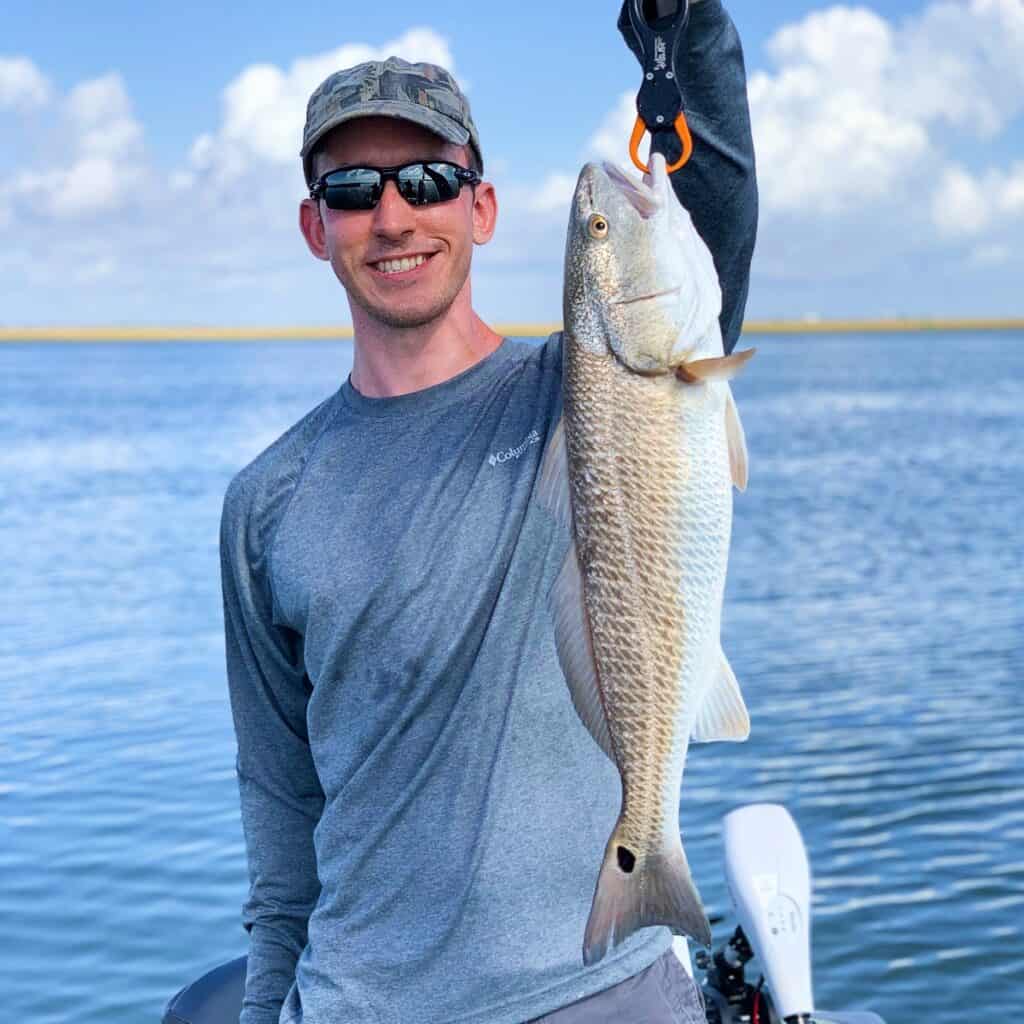
Written By: Andrew Juran
Andrew is a seasoned angler with over 25 years of experience fishing across the United States. He has caught hundreds of inshore fish using various techniques and mentored many in the art of fishing. An advocate for sustainable fishing, Andrew is an active member of the Coastal Conservation Association, an organization committed to marine conservation.
For frequent fishing tips, behind-the-scenes looks, and real-time catches, connect with Andrew on Instagram
